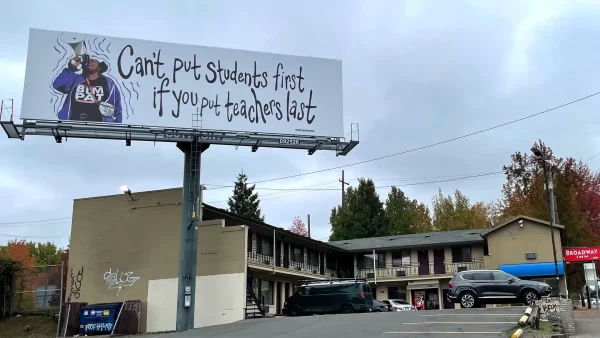Showdown to May 8th
On February 18th, 2019, 2500 educators in the state of Oregon marched in Salem demanding for better school funding. On April 4th, the Joint Committee for Student Success gave an answer with an investment plan that would cover early education and K-12 schools. With this proposal, an even bigger march is being organized for May 8th, a statewide teacher walk-out to advocate for the Student Success Act. To understand the passion behind the current protest, one has to only look back at the 29 years of state budgets and finding.
One popular reason state funding for schools is lower than the national average in Oregon is because of Ballot Measure #5. The ballot measure was passed in 1990, and it changed how households would be taxed and where school funding would come from. Originally, schools with higher household values had more funding in local schools, the same went for lower income areas with local schools; the measure changed it to higher spending in higher populated schools instead. It also capped the taxes to households, and shifted public school funding from local to state taxes. This has led to decades of underfunding schools, with legislators and educators demanding a change.
One consequence to the low funding is lack of needed resources for students. In an interview with Melissa Marchant, a librarian for Milwaukie High School, she talked about low funding and the effects on specialists and resources. “It’s been tougher for Oregon schools to have the kind of funding that they need for everything from supplies to keeping class sizes lower. So that’s hiring enough teachers, having specialists like librarians. Librarians have been cut and counselors have been cut.” Students are not getting the resources they need, which has led to several unhealthy teaching environments. In 2018, The Joint Committee for Student Success mentions one of several unsuitable environments. “One teacher reported to the committee that he had 45 students in a math class, but only 40 desks in his classroom.” The report lists other moments for early education, middle schools and high schools, all with similar circumstances. Low funding is an issues that affects entire generations of students, and can lead to future generations getting lackluster services and education.
A lack of resources has had negative results in student graduation rates in high schools. In 2018, USA Today wrote a list of state schools based off of graduation rates, financial situations and the number of bachelor graduates. The list ranked Oregon at 34, mentioning its low funding, and its 74.8% graduation rate, which is lower than the national average of 84.1%.
Another resource that was cut was mental health services, which puts teachers as the the first available resource for students. In the legislative report, it was a common request for better services: ”In most schools, classroom teachers spend an increasing amount of time and effort dealing with issues that are better dealt with by other professionals.” Phil Marchant, a science teacher in Milwaukie High School, was asked if it’s hard for educators to aid students with mental health issues. “Yeah, because we were not trained in mental health issues, even though we’re around kids all the time. (…) And so it’s been difficult to have that role is also being on the front line trying to diagnose and get them helping.” The Joint Committee reviewed schools from around the country from early ed to K-12, and found that all lacked the same services.
The Joint Committee for Student Success was made in 2018 with the goal of studying public schools across all the districts of Oregon, in order to find out what needed funding, and how much should be given. The Student Success Act was made to organize a proposed 2 billion dollars of funding into three percentages. In summary:
- 20% will go to early learning to supply intervention and special education services, and better support for the federal Head start program for the families of students in poverty.
- 50% will go to school improvement, where it will be used to expand learning time, reduce class sizes, and and give emphasis to mental and emotional health and services.
- 30% will go to statewide initiatives like better nutrition programs, Student Success teams for underperforming schools, and statewide equity programs for Black, Latino, and Native American students to improve graduation rates.
Oregon has always been known for its lower funding in education, especially when compared to neighboring states like Washington or California. In 2012, Oregon spent $3,041,825 on public education expenditures, which made up for 14.3% of the state budget. It is significantly less when compared to other states in the same year, like the 21.4% budget spending in California, and the 23.4% in Washington. In Washington, that percentage adds up to $7,160,395, and is more than double the amount Oregon spent on education in 2012.
Oregon had spent $7.4 billion in its 2017-2019 biennial report, not meeting the 9.2 billion the Quality Education Model projected. Today, the state has spent over 8.2 billion dollars in education for its 2019 biennial, but as OSBA mentions in a 2018 article, this doesn’t reach the minimum requirement. “Oregon would need to spend $10.7 billion for 2019-21 for a K-12 system that meets Oregon’s education goals, $2.5 billion more than the 2017-19 State School Fund.” The Student Success is vital to teachers for this reason, because it makes the budget the closest it’s ever been to the minimum schools need.
There is a possibility that state lawmakers won’t vote for the Student Success Act, which is why the May 8th protest is happening. Earlier protests, like that in Wisconsin in 2011, failed to change that state legislature to accommodate for teachers, which they are still protesting to this day. Or the May 8th protest can persuade Oregon lawmakers, like in West Virginia, which succeeded in its own statewide teacher walkout, bringing a 5% increase in state employee paychecks. This may be another state bringing support to schools or another that neglects them. Either way, the protest itself could last much longer than May 8th, it could last weeks, months or even years if no progress is made like in Wisconsin. The Student Success Act is expected to be voted on by both chambers of the legislature in the beginning of May, so educators will have an answer soon.










